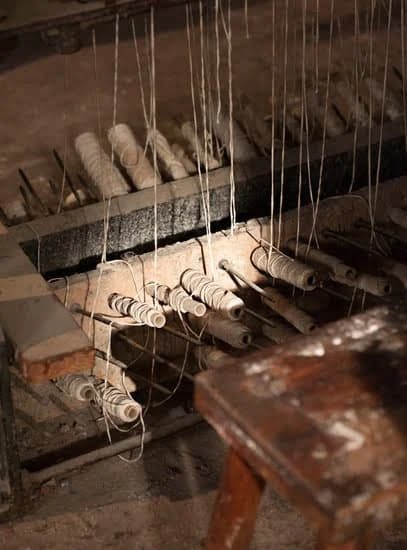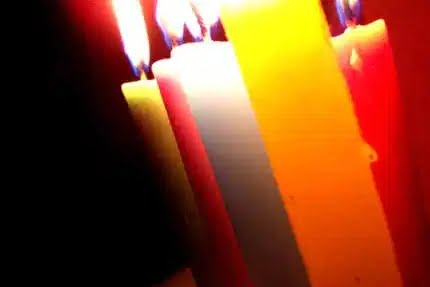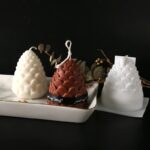When it comes to candle making, one ingredient that plays a crucial role in achieving desired results is stearic acid. Known for its versatility and numerous benefits, stearic acid is commonly used by candle makers to enhance the texture, hardness, and burn time of their creations.
Stearic acid, also referred to as octadecanoic acid, is a saturated fatty acid derived from animal or vegetable sources. It has a waxy appearance and solidifies at room temperature. In candle making, stearic acid serves multiple purposes. Firstly, it acts as a hardening agent, providing rigidity and durability to the candles.
This ensures that they maintain their shape while burning without sagging or drooping. Secondly, stearic acid helps to reduce the melting point of other waxes used in candle making, which allows for a cleaner and more efficient burn. Finally, stearic acid contributes to the overall aesthetic appeal of candles by adding a subtle shimmer and improving color stability.
Understanding the importance of stearic acid in candle making requires delving into its chemical composition and properties. The science behind stearic acid reveals that it has a long chain structure consisting of 18 carbon atoms bonded together.
This unique molecular arrangement makes stearic acid insoluble in water but soluble in organic solvents like ethanol or turpentine oil. Additionally, its high melting point of around 70 degrees Celsius makes it an ideal additive for increasing the melting point of lower-melting-point waxes commonly used in candle production.
In the following sections of this article, we will explore the specific benefits that result from using stearic acid in candle making. From improving texture and hardness to extending burn time, stearic acid offers valuable advantages for both hobbyists and professional candle makers alike.
Additionally, we will discuss the different forms in which stearic acid is available and how each form influences its suitability for various candle making techniques. So let’s dive deeper into the world of stearic acid and unlock its potential for creating beautiful and long-lasting candles.
The Science Behind Stearic Acid
Stearic acid is a saturated fatty acid that is derived from animal and vegetable sources. It is important in candle making due to its unique chemical composition and properties that contribute to the production of high-quality candles.
In terms of its chemical composition, stearic acid consists of long chains of carbon atoms with a carboxyl group at one end. This structure gives it its waxy texture and solid form at room temperature. The length of the carbon chain can vary, which determines the consistency and melting point of the stearic acid.
One of the main benefits of using stearic acid in candle making is its ability to increase the hardness and durability of candles. When stearic acid is added to candle wax, it helps to solidify the wax, resulting in a more stable candle that is less likely to wilt or deform under heat or pressure. This makes stearic acid particularly useful for creating pillar candles or other intricate candle designs that require a sturdy base.
Furthermore, stearic acid also plays a role in extending the burn time of candles. The addition of stearic acid increases the melting point of the wax, which means that the wax will melt at a higher temperature during burning. As a result, candles made with stearic acid tend to have slower and more controlled burning rates, allowing them to last longer compared to candles without this ingredient.
Overall, understanding the chemical composition and properties of stearic acid allows candle makers to utilize this ingredient effectively in their candle production. By incorporating stearic acid into their recipes, they can achieve desirable qualities such as increased hardness and extended burn time for their candles.
| Properties | Benefits |
|---|---|
| Increases hardness | Makes candles more durable |
| Raises melting point | Results in slower and controlled burning |
Benefits of Using Stearic Acid in Candle Making
Stearic acid is a valuable ingredient in candle making due to the numerous benefits it brings to the texture, hardness, and burn time of candles. One of the primary advantages of using stearic acid is its ability to enhance the hardness and solidity of candles. This results in candles that are less likely to bend or warp during handling or burning, providing a more aesthetically pleasing and durable finished product.
In addition to improving the physical properties of candles, stearic acid also plays a crucial role in extending their burn time. Stearic acid has a higher melting point than other common candle waxes, which means that it helps to raise the melting point of the overall wax blend when added in appropriate quantities.
As a result, candles made with stearic acid are able to withstand higher temperatures without softening or losing their shape, leading to a slower and more controlled burn.
Another benefit of using stearic acid in candle making is its contribution to the overall texture and appearance of candles. When incorporated into wax formulations, stearic acid can create a smooth and creamy texture that enhances the visual appeal of candles. It also helps reduce surface imperfections such as cracks or sinkholes that may occur during cooling and drying processes.
Overall, adding stearic acid to candle recipes can greatly improve the quality and performance of homemade candles. Whether you are looking to create harder, longer-lasting candles or simply aiming for a more visually appealing final product, incorporating stearic acid into your candle making process can help you achieve these goals effectively.
| Advantages | Description |
|---|---|
| Enhances hardness | Improves durability and prevents bending/warping |
| Extends burn time | Higher melting point allows for slower and more controlled burn |
| Improves texture | Creates a smooth and creamy texture, reduces surface imperfections |
Different Forms of Stearic Acid
Powder Form
One of the available forms of stearic acid for candle making is in powder form. This fine, powdered texture makes it easy to incorporate into candle formulations. The powder form of stearic acid is often preferred by candle makers who are looking for a faster melting time and a smooth finish on their candles. It quickly dissolves when added to melted wax, allowing for even distribution throughout the candle mixture.
Flake Form
Another common form of stearic acid used in candle making is in flake form. These flakes have a slightly larger particle size compared to the powder form, which provides some benefits in the candle making process.
The larger surface area of the flakes allows for a slower melting time, giving candle makers more control over the temperature and consistency of their melted wax. Flakes also provide a textured appearance when added to candles, creating a rustic or vintage look that some candle makers prefer.
Beads Form
Stearic acid beads are less commonly used but offer unique advantages for certain candle making techniques. The spherical shape and small size of the beads make them ideal for slow-release fragrance candles or layered designs. These beads slowly melt as the candle burns, allowing for a controlled release of fragrance oils or dyes that can be incorporated into different layers of a multi-colored or scented candle.
When choosing between these different forms of stearic acid, consider your desired outcome and specific candle making techniques. Powdered stearic acid works well for smooth, high-quality candles, while flaked stearic acid adds texture and visual interest. Beads provide opportunities for creative experimentation with fragrance release and layered designs. Experimenting with different forms can help you achieve unique results and enhance your overall candle making experience.
Incorporating Stearic Acid into Candle Recipes
Stearic acid is a versatile ingredient that can be easily incorporated into candle recipes to enhance their texture, hardness, and burn time. If you’re new to working with stearic acid in candle making, here are some step-by-step instructions on how to successfully include it in your candle formulations.
Firstly, it’s important to determine the appropriate ratio of stearic acid to use in your candles. The recommended ratio is typically between 5-10% of the total wax weight. This means that if you’re using 100 grams of wax, you would add anywhere from 5-10 grams of stearic acid.
To incorporate stearic acid into your candles, begin by melting your wax as you normally would. Once the wax has reached its desired temperature and consistency, slowly add the measured amount of stearic acid into the melted wax. Stir gently but thoroughly to ensure even distribution of the stearic acid throughout the mixture.
It’s worth noting that stearic acid has a higher melting point than most waxes, so it may take slightly longer for your wax-stearic acid blend to fully melt. Be patient and continue stirring until all the ingredients have completely dissolved and combined.
When incorporating stearic acid into your candle recipes, keep in mind that different forms of stearic acid may require different methods of incorporation. For example, if you’re using stearic acid powder, it can be added directly to the melted wax during the melting process. On the other hand, if you’re using stearic acid flakes or beads, they may need to be melted separately before adding them to the main batch of melted wax.
By following these step-by-step instructions and experimenting with different ratios and forms of stearic acid, you can achieve the desired results in your candle making. Whether you’re looking to create candles with a longer burn time or ones that are more resistant to melting in warmer temperatures, stearic acid is an invaluable ingredient for achieving these goals.
Enhancing Candle Aesthetics with Stearic Acid
In addition to its practical benefits in candle making, stearic acid also offers exciting possibilities for enhancing the aesthetics of candles. Candle makers can leverage the unique properties of stearic acid to create stunning designs, textures, and decorative effects that make their candles stand out.
One popular technique for incorporating stearic acid into candle designs is called “marbling.” By melting stearic acid along with colored wax, candle makers can achieve beautiful swirls and patterns reminiscent of marble stone. This technique allows for endless creativity as different color combinations can be used to create a wide range of marbled effects. The smooth texture and ease of manipulation make stearic acid a preferred choice for achieving consistent results.
Another way to add visual interest using stearic acid is by creating textured candles. When blended with wax, stearic acid can alter the consistency of the final product, resulting in a more rigid and durable texture.
This characteristic allows candle makers to experiment with various molding techniques such as embedding objects or creating intricate carvings on the surface of the candles. The addition of stearic acid provides stability and structure to these designs, ensuring they withstand the rigors of burning while maintaining their intended appearance.
Furthermore, decorative effects can be achieved by using stearic acid in combination with other materials such as glitter or fragrance oils. By incorporating these elements into the melted mixture containing stearic acid, candle makers can produce candles that sparkle or emit enticing aromas when lit. These additional embellishments not only enhance the visual appeal of candles but also create a multisensory experience for users.
Safety Considerations When Working with Stearic Acid
Importance of Safety Measures
When working with stearic acid in candle making, it is crucial to prioritize safety. Stearic acid, like any other chemical compound, can pose potential hazards if not handled properly. Therefore, it is essential to understand and implement the necessary safety measures and precautions to ensure a safe working environment.
Protective Gear and Clothing
Before starting any candle-making project involving stearic acid, it is recommended to wear appropriate protective gear. This includes goggles or safety glasses to protect your eyes from potential splashes or spills. Additionally, wearing gloves made of nitrile or butyl rubber can provide protection against skin contact with stearic acid, which may cause irritation.
In terms of clothing, it is advisable to wear long sleeves and pants made of non-flammable materials to prevent accidental contact with molten stearic acid. Closed-toe shoes should also be worn to protect the feet from potential spills or splashes.
Ventilation and Workspace
Another important safety consideration is ensuring proper ventilation in the workspace where stearic acid is being melted or handled. Stearic acid releases fumes when heated, which can be irritating or harmful if inhaled in large quantities. Working in a well-ventilated area or using an exhaust fan can help dissipate the fumes and maintain air quality.
Additionally, it is crucial to have a clean and clutter-free workspace when working with stearic acid. This minimizes the risk of accidents caused by tripping over objects or knocking over containers filled with hot liquid.
Fire Safety
As stearic acid is flammable, fire safety precautions should be taken seriously during candle making. Ensure that you have a fire extinguisher within reach at all times and know how to use it effectively. Never leave melting stearic acid unattended and always keep a close eye on the heat source.
In case of a fire, do not attempt to extinguish it with water as stearic acid is not water-soluble and can spread the fire. Instead, use a fire extinguisher specifically designed for chemical fires or smother the flames with baking soda or sand.
By following these safety measures and precautions, candle makers can minimize the risk of accidents and ensure a safe working environment when handling and melting stearic acid. It is important to prioritize safety at all times to avoid any potential harm or damage during the candle making process.
Troubleshooting Common Issues with Stearic Acid in Candle Making
When working with stearic acid in candle making, it’s important to be aware of some common issues that may arise. By understanding these challenges and the solutions to overcome them, candle makers can ensure a successful candle-making experience.
One common issue that candle makers may encounter when using stearic acid is an uneven burn. This can result in a candle tunneling, where only a small portion of the wax is melting and the rest remains untouched. To prevent this issue, it is recommended to properly blend the stearic acid with other waxes or additives before pouring into molds. Ensuring that the mixture is homogeneous will help promote even burning throughout the entire candle.
Another challenge that may arise is difficulty in achieving a consistent texture or hardness in the finished candles. If the stearic acid concentration is too high, the candles may become too hard and brittle. On the other hand, if the concentration is too low, the candles may not set properly and have a soft texture.
To achieve the desired texture and hardness, it’s important to experiment with different ratios of stearic acid in your candle formulations. Starting with smaller amounts and gradually increasing until you achieve your desired results can help prevent issues with texture.
Lastly, cracking can be another concern when using stearic acid in candle making. Cracking often occurs due to rapid cooling or sudden temperature changes during the cooling process. To avoid this issue, it’s recommended to cool your candles slowly at room temperature after pouring them into molds. This gradual cooling process helps prevent cracking and ensures that your candles maintain their shape.
DIY Candle Making Projects using Stearic Acid
In addition to its practical benefits in candle production, stearic acid offers endless creative possibilities for candle makers. By incorporating stearic acid into your candle recipes, you can create unique and visually stunning candles that are sure to impress. Here are a few DIY candle making projects that utilize stearic acid:
- Layered Candles: One popular technique is creating layered candles with different colors or scents. To create layered candles using stearic acid, start by melting the desired amount of stearic acid and adding colorant or fragrance oil to each layer. Pour the first layer into the container and allow it to cool and solidify before repeating with subsequent layers. The result is a beautiful, multi-colored candle that adds visual interest when lit.
- Embedded Object Candles: Another fun project involves embedding objects within the candle itself. With stearic acid, you can achieve an even distribution of embedded objects throughout the candle without them sinking or floating to one side.
Simply melt the stearic acid, add your desired embedment such as dried flowers, beads, or small trinkets, and carefully pour the mixture into the container while holding the objects in place with a skewer or toothpick until set. This allows you to create personalized candles for special occasions or gifts. - Textured Candles: If you’re looking to add texture to your candles, stearic acid can help you achieve that as well. By incorporating small amounts of powdered stearic acid into your wax blend, you can create a textured surface on your finished candle.
This can be done by dusting the inside of your mold with powdered stearic acid before pouring in the melted wax or by sprinkling a thin layer of powdered stearic acid on top of the poured candle before it completely hardens. The result is a visually interesting candle with a unique texture.
By experimenting with different techniques and incorporating stearic acid into your candle making, you can take your creations to the next level. Whether you’re making layered candles, embedding objects, or adding texture, stearic acid offers endless possibilities for creating one-of-a-kind candles that are both visually stunning and long-lasting. So get creative and start exploring the world of candle making with stearic acid today.
Conclusion
In conclusion, Stearic Acid plays a crucial role in candle making due to its numerous benefits and versatility. Throughout this blog post, we have explored the chemical composition and properties of Stearic Acid that make it so beneficial for achieving desired results in candle production.
By incorporating Stearic Acid into candle recipes, candle makers can enhance the texture, hardness, and burn time of their candles. Whether using it in powder, flakes, or bead form, there are various options available to suit different candle making techniques. The step-by-step instructions provided in this article offer practical guidance on how to successfully incorporate Stearic Acid into your candle formulations.
Furthermore, Stearic Acid offers endless possibilities for enhancing candle aesthetics. With its ability to create unique designs, textures, and decorative effects, candle makers can unleash their creativity and produce candles that stand out among the rest.
It is important to note the safety considerations when working with Stearic Acid. Always prioritize safety measures and precautions when handling and melting this ingredient to ensure a safe working environment.
In closing, the significance of Stearic Acid in candle making cannot be overstated. Not only does it improve the quality and performance of candles, but it also allows for limitless creativity in designing unique candles.
We encourage readers to experiment with this versatile ingredient and explore the vast array of DIY candle making projects highlighted in this blog post. Embrace the possibilities that Stearic Acid presents and create candles that are not only visually appealing but also burn beautifully with a long-lasting glow.

Welcome to my candle making blog! In this blog, I will be sharing my tips and tricks for making candles. I will also be sharing some of my favorite recipes.





